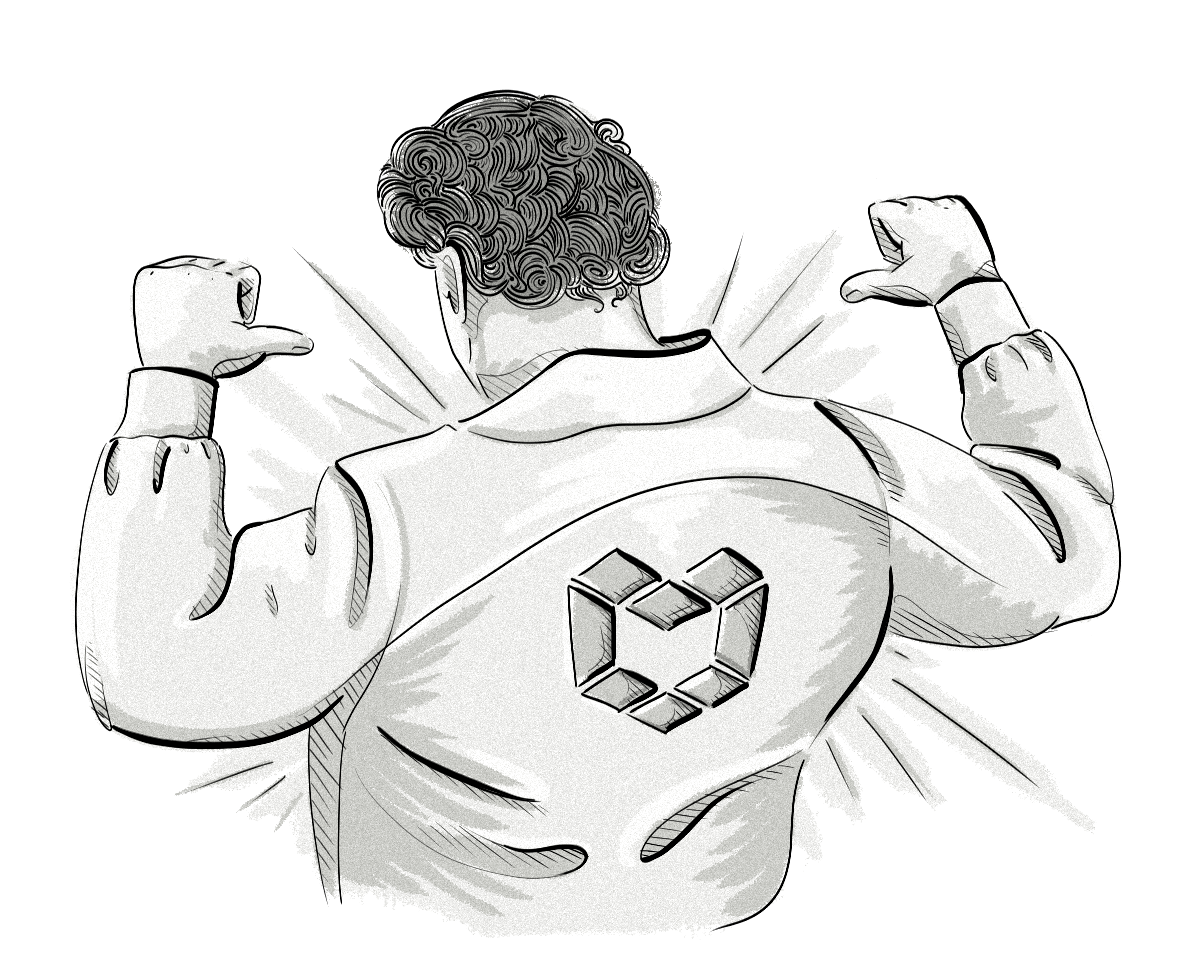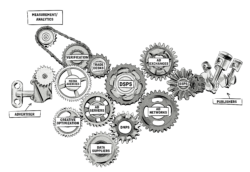The question of building, renting or buying an AdTech or MarTech platform, such as a supply-side platform (SSP), bidder, demand-side platform (DSP), or customer data platform (CDP), is one that many tech companies, brands, and agencies often ask themselves.
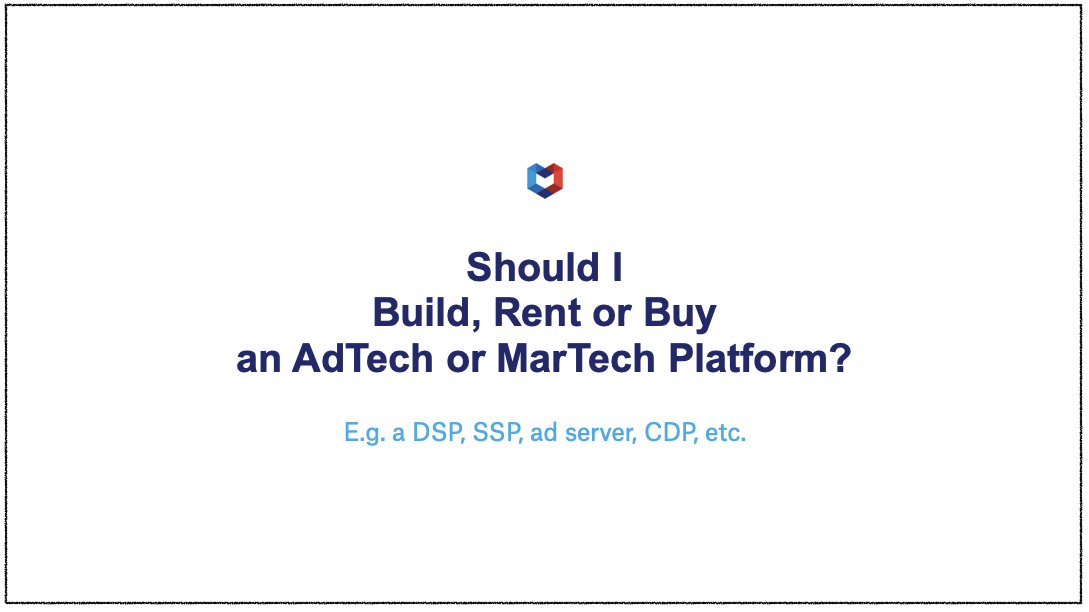
Build vs Rent vs Buy: A Decision Tree
Many companies that enquire about our AdTech and MarTech development services often ask us about whether they should build, rent or buy an AdTech or MarTech platform.
To help our partners, as well as other tech companies, brands, agencies, and publishers, with making this decision, we’ve created a simple decision tree:
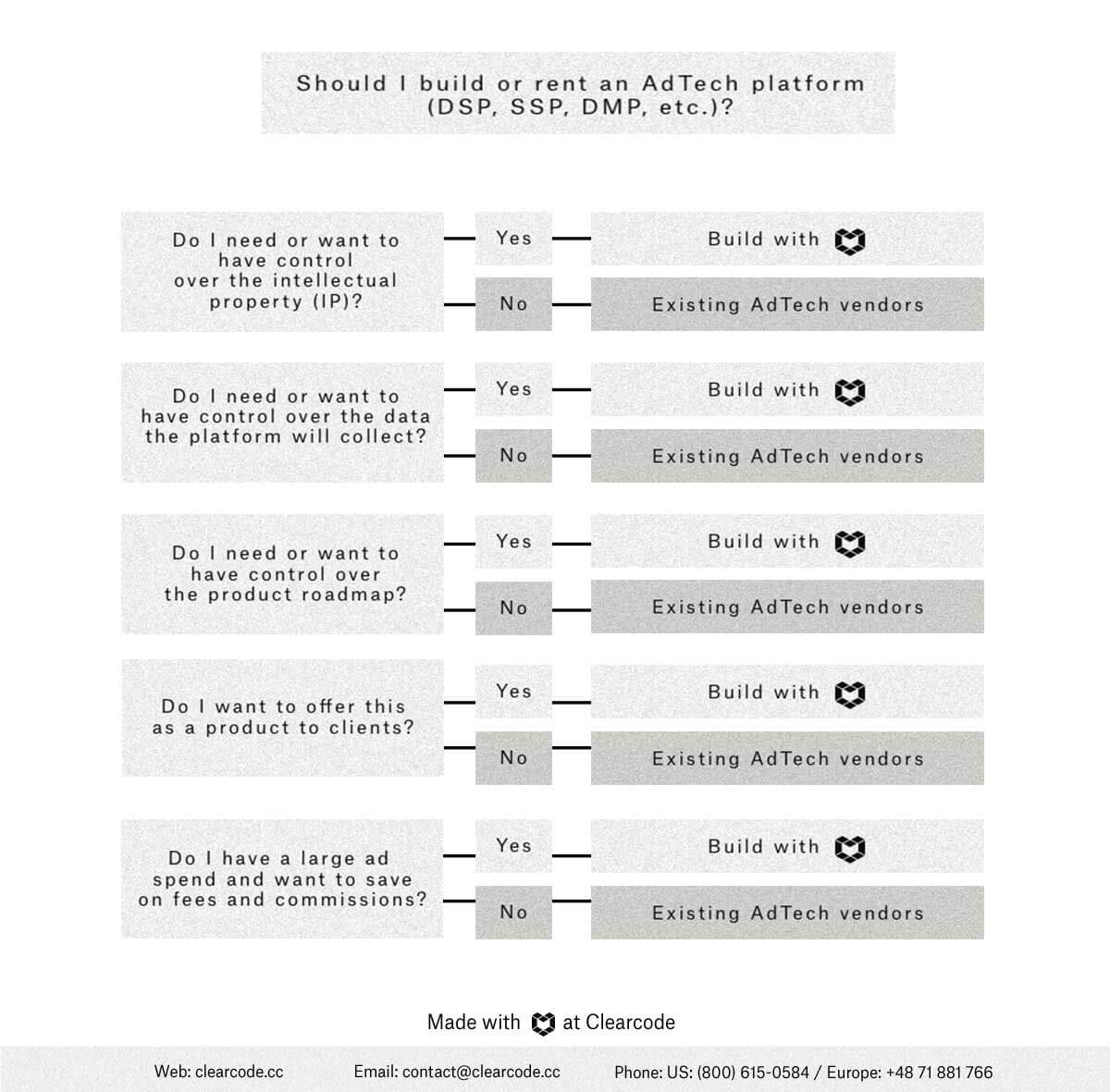
Who Benefits from Building, Renting or Buying an AdTech or MarTech Platform?
Who benefits from building an AdTech or MarTech platform?
- AdTech and MarTech companies.
- Tech companies from other industries.
- Medium- and large-sized publishers and agencies.
- Media companies.
Who benefits from renting an AdTech or MarTech platform?
- Brands and small- and medium-sized agencies.
- Small- and medium-sized publishers.
Who benefits from buying an AdTech or MarTech platform?
- Large companies, e.g. telcos.
- Private equity companies.
What Does It Mean to Build, Rent and Buy an AdTech or MarTech Platform?
The topic of building, renting, and buying AdTech and MarTech platforms has been around for over a decade and raises its head from time to time, but there is often some confusion about what these terms mean.
Below is an overview of how we interpret these terms:
What Does Building an AdTech or MarTech Platform Mean?
This relates to software development where you build the platform, usually from the ground up. This includes designing the UX/UI (i.e. the user interface), writing the code (both backend and frontend) and testing it, and designing the infrastructure’s architecture.
The time it takes to design and build the minimum viable product (MVP) of an AdTech or MarTech platform varies depending on a number of factors, including:
- Budget and timeframes: A large budget will mean that more developers (e.g. 6+) can work on the project, resulting in the MVP’s release sooner. Essentially, the more developers working on the project the shorter it will take to build.
- Features: The more features you want to include in MVP, the longer it will take to build. Generally, the MVP will contain only the necessary set of features needed to test the platform with initial users and stakeholders.
- Technical complexities: Regardless of the type of AdTech or MarTech platform you want to build, there are always some key challenges that will need to be resolved, such as setting up the integrations with other AdTech, MarTech, and data platforms.
In software development, the goal is to design and build the MVP of a product within 6 months, but this largely depends on the factors listed above and also the client’s business goals and requirements. Some projects may last 6 months while others may last 18 months.
At Clearcode, we’ve worked on many AdTech and MarTech development projects over the years. If you’d like to learn more about what’s involved in designing and building these platforms, then view our case studies below or get in contact with our team.
Case studies of AdTech and MarTech development projects we’ve worked on:
- Supply-Side Platform (SSP) Development
- AdTech Stack Development Project for an OTT Publisher
- Demand-Side Platform (DSP) Development
- Personalization and Ad Serving Platform
- Analytics Suite Development Project for Piwik PRO
What Does Renting an AdTech or MarTech Platform Mean?
Renting an AdTech or MarTech platform essentially means signing an agreement with an existing vendor and then paying a subscription or licensing fee, usually on a monthly basis. This is by far the most popular option as it allows companies to start using the platform straightaway, i.e. they don’t have to build it first.
What Does Buying an AdTech or MarTech Platform Mean?
Buying an AdTech or MarTech platform typically means acquiring an existing company and using the tech for your own purposes or adding it to your client offering.
This is the least popular option because it typically requires a large sum of money for both the legal work (e.g. doing due diligence and all the legal costs associated with acquiring a company) and the actual purchase of the company (i.e. the AdTech or MarTech vendor).
Although the AdTech and MarTech industries have recently seen an increase in merger and acquisition (M&A) activity, buying an existing platform is really only for the large players with a lot of available cash.
Here are some recent AdTech and MarTech acquisitions:
- Twillio acquired Segment for $3.2 billion in October 2020.
- BloomReach acquired Exponea in January 2021 (deal information undisclosed).
- AppLovin acquired MoPub from Twitter for just over $1 billion.
- TransUnion acquired Neustar for $3.1 billion.
- Magnite acquired SpotX for $1.17 billion.
Building an AdTech or MarTech Platform
What are the advantages of building an AdTech or MarTech platform (DSP, SSP, CDP, etc)?
Below are the main advantages of building your own AdTech platform:
- Data ownership — owning the data you collect makes it easier for you and your clients to comply with various data protection and privacy laws, such as the GDPR. You’ll also eliminate the risk of your data being used by your competitors.
- Ownership of the intellectual property (IP) — not only will this give you control over the code base and algorithms, but it can also increase the value of your company.
- Control over the features and product roadmap — you can create proprietary features and algorithms to differentiate yourself from the competition. This not only ensures you get the features you want but also means the platform will be built to achieve your business’s goals, strategy and vision.
- Reduction of fees and commissions — most AdTech vendors charge a markup of 10% to 30%, which can add up if you have a large ad spend or inventory. Building your own AdTech platform can lower this amount and help you save millions of dollars per year.
What are the disadvantages of building an AdTech or MarTech platform (DSP, SSP, CDP, etc)?
The main drawback of building your own AdTech platform is that it requires a large financial and time investment, particularly in the beginning, compared to renting an AdTech platform. It may take a minimum of 6 months to build the first working version of your platform (i.e. the MVP) but it will take much less time to get up and running with an existing AdTech or MarTech platform.
However, if your goal is to earn revenue from the platform by offering it to clients, then this isn’t so much of an issue as your goal will be to get a return on your investment over time.
You’ll also need to consider how you’ll provide the technical support needed to maintain the platform after it’s been built. Often, the development company that built the MVP for you can offer ongoing monitoring and maintenance of the platform.
Renting an AdTech or MarTech Platform
What are the advantages of renting an AdTech or MarTech platform (DSP, SSP, CDP, etc)?
Below are the main advantages of renting an AdTech platform (i.e. using an existing platform):
- You can start running campaigns straightaway — in most cases, you can start buying or selling media within hours of creating an account.
- Lower upfront cost — a majority of AdTech platforms charge a percentage of media spend, meaning you don’t need to pay any upfront costs. This typically isn’t the case with some white-labelled solutions or larger AdTech vendors as these may charge an ongoing monthly fee on top of media spend.
What are the disadvantages of renting an AdTech or MarTech platform (DSP, SSP, CDP, etc)?
The main disadvantages of renting an AdTech or MarTech platform are:
- No control over the features or product roadmap: When renting an AdTech or MarTech platform, you have little to no control over its current or future features. This can be problematic if you’re using the platform on behalf of your clients as you won’t be able to build new features that they request.
- No ownership of the tech or data: While most companies (e.g. agencies and brands) don’t need to own the tech or data, there are some companies whose only option is to own the tech and data, i.e. AdTech and MarTech companies. Publishers, media companies, telcos, and medium- and large-size agencies can also benefit from owning the intellectual property as it will provide them with full control of the tech, which is important when integrating it with their other systems, and also can often increase the value of their company.
- Fees and commissions: Depending on the type of company you run and how much you spend on media or earn from ad revenue, you may find that building your own AdTech or MarTech platform can help you save money in the long run, even when you take into account the cost to build and maintain it.
Buying an AdTech or MarTech Platform
What are the advantages of buying an AdTech or MarTech platform (DSP, SSP, CDP, etc)?
The main advantages of buying an AdTech or MarTech platform are similar to those you’ll get if you build it, such as ownership of the tech, IP, and data.
You’ll also have control over the features and product roadmap, however, you may be somewhat limited in what customizations, integrations, and features you can build. It will all depend on how the platform has been built, e.g. the quality of the codebase and the infrastructure’s architecture.
There’s also the added advantage of being able to make use of the platform immediately, instead of having to wait for it to be built.
Buying an AdTech or MarTech platform can also provide you with a competitive advantage, such as if you acquire a platform that allows you to gain instant access to a specific industry or introduce new revenue streams.
We saw this scenario play out with telcos over the past few years. One prime example is AT&T’s acquisition of AppNexus (now Xander) to enter the AdTech industry. However, not all AdTech acquisitions have worked out for telcos.
Other examples can be found in other industries, such as media. Recently, Roku acquired the DSP vendor dataxu to expand its advertising business.
What are the disadvantages of buying an AdTech or MarTech platform (DSP, SSP, CDP, etc)?
The main disadvantage of buying an AdTech or MarTech platform is the cost.
There are many costs associated with acquiring a tech company, including legal fees and the actual purchasing costs. Most of the time, the cost to acquire a tech company will be many millions of dollars, but can even be in the hundreds of millions or even billions.
For that reason, this option is typically reserved for established companies with a lot of capital behind them.
There’s also the risk that the acquisition may not result in a positive ROI or bring additional value (in money terms) to the company. We’ve seen many examples of companies acquiring tech companies only for them to sell them off or write them down a few years later.
In many cases, building an AdTech or MarTech platform will work out cheaper than acquiring an existing one and it can help you decrease risk by incrementally building the tech and getting feedback from users along the way to increase the value of it over time.
FAQs About Building AdTech and MarTech Platforms
How long does it take to build an AdTech or MarTech platform?
This largely depends on the software development process.
For example, the AdTech development teams at clearcode aim to build a working minimum viable product (MVP) within 4-6 months.
The image below illustrates our software development process when building AdTech and MarTech products:
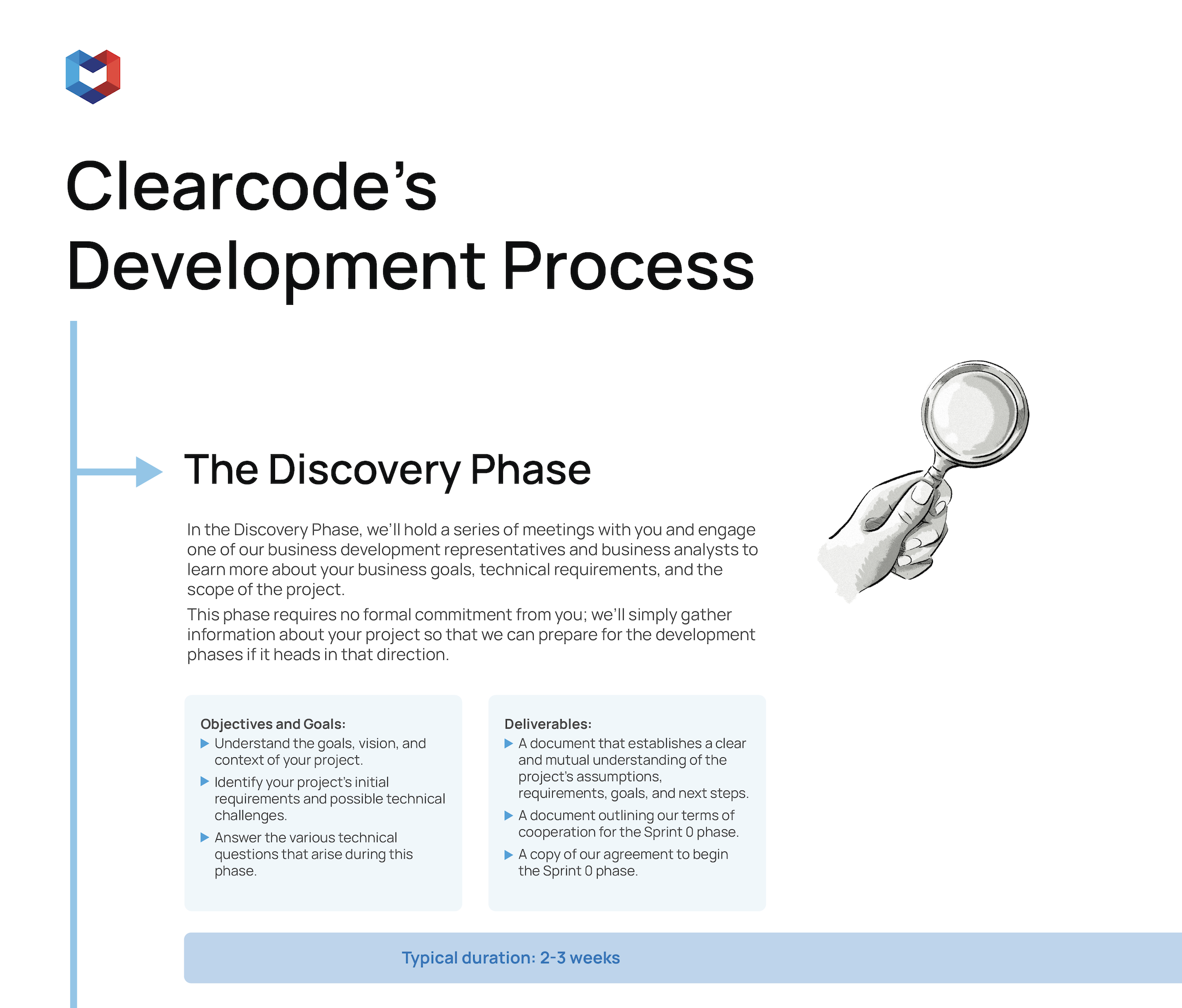
How much does it cost to build an AdTech or MarTech platform?
Similarly to the above question, this will vary across software development companies.
If you are evaluating different development options (e.g. an in-house development team, outsourcing company, or a specialized technical partner), it’s just as important to evaluate their experience in designing, building, and maintaining AdTech platforms as it is their proposed costs for the project.
Working with an inexperienced development team may work out cheaper in the shorterm, but if they don’t know how the online advertising technology ecosystem works, then it might mean that you’ll spend $100,000 dollars on an MVP that doesn’t work at all or doesn’t meet the main business objectives (e.g. buy video inventory from premium websites).
